Gaotang Li
Beyond Log Likelihood: Probability-Based Objectives for Supervised Fine-Tuning across the Model Capability Continuum
Oct 01, 2025Abstract:Supervised fine-tuning (SFT) is the standard approach for post-training large language models (LLMs), yet it often shows limited generalization. We trace this limitation to its default training objective: negative log likelihood (NLL). While NLL is classically optimal when training from scratch, post-training operates in a different paradigm and could violate its optimality assumptions, where models already encode task-relevant priors and supervision can be long and noisy. To this end, we study a general family of probability-based objectives and characterize their effectiveness under different conditions. Through comprehensive experiments and extensive ablation studies across 7 model backbones, 14 benchmarks, and 3 domains, we uncover a critical dimension that governs objective behavior: the model-capability continuum. Near the model-strong end, prior-leaning objectives that downweight low-probability tokens (e.g., $-p$, $-p^{10}$, thresholded variants) consistently outperform NLL; toward the model-weak end, NLL dominates; in between, no single objective prevails. Our theoretical analysis further elucidates how objectives trade places across the continuum, providing a principled foundation for adapting objectives to model capability. Our code is available at https://github.com/GaotangLi/Beyond-Log-Likelihood.
Graph Homophily Booster: Rethinking the Role of Discrete Features on Heterophilic Graphs
Sep 16, 2025Abstract:Graph neural networks (GNNs) have emerged as a powerful tool for modeling graph-structured data. However, existing GNNs often struggle with heterophilic graphs, where connected nodes tend to have dissimilar features or labels. While numerous methods have been proposed to address this challenge, they primarily focus on architectural designs without directly targeting the root cause of the heterophily problem. These approaches still perform even worse than the simplest MLPs on challenging heterophilic datasets. For instance, our experiments show that 21 latest GNNs still fall behind the MLP on the Actor dataset. This critical challenge calls for an innovative approach to addressing graph heterophily beyond architectural designs. To bridge this gap, we propose and study a new and unexplored paradigm: directly increasing the graph homophily via a carefully designed graph transformation. In this work, we present a simple yet effective framework called GRAPHITE to address graph heterophily. To the best of our knowledge, this work is the first method that explicitly transforms the graph to directly improve the graph homophily. Stemmed from the exact definition of homophily, our proposed GRAPHITE creates feature nodes to facilitate homophilic message passing between nodes that share similar features. Furthermore, we both theoretically and empirically show that our proposed GRAPHITE significantly increases the homophily of originally heterophilic graphs, with only a slight increase in the graph size. Extensive experiments on challenging datasets demonstrate that our proposed GRAPHITE significantly outperforms state-of-the-art methods on heterophilic graphs while achieving comparable accuracy with state-of-the-art methods on homophilic graphs.
Saffron-1: Towards an Inference Scaling Paradigm for LLM Safety Assurance
Jun 06, 2025Abstract:Existing safety assurance research has primarily focused on training-phase alignment to instill safe behaviors into LLMs. However, recent studies have exposed these methods' susceptibility to diverse jailbreak attacks. Concurrently, inference scaling has significantly advanced LLM reasoning capabilities but remains unexplored in the context of safety assurance. Addressing this gap, our work pioneers inference scaling for robust and effective LLM safety against emerging threats. We reveal that conventional inference scaling techniques, despite their success in reasoning tasks, perform poorly in safety contexts, even falling short of basic approaches like Best-of-N Sampling. We attribute this inefficiency to a newly identified challenge, the exploration--efficiency dilemma, arising from the high computational overhead associated with frequent process reward model (PRM) evaluations. To overcome this dilemma, we propose SAFFRON, a novel inference scaling paradigm tailored explicitly for safety assurance. Central to our approach is the introduction of a multifurcation reward model (MRM) that significantly reduces the required number of reward model evaluations. To operationalize this paradigm, we further propose: (i) a partial supervision training objective for MRM, (ii) a conservative exploration constraint to prevent out-of-distribution explorations, and (iii) a Trie-based key--value caching strategy that facilitates cache sharing across sequences during tree search. Extensive experiments validate the effectiveness of our method. Additionally, we publicly release our trained multifurcation reward model (Saffron-1) and the accompanying token-level safety reward dataset (Safety4M) to accelerate future research in LLM safety. Our code, model, and data are publicly available at https://github.com/q-rz/saffron , and our project homepage is at https://q-rz.github.io/p/saffron .
MORALISE: A Structured Benchmark for Moral Alignment in Visual Language Models
May 20, 2025Abstract:Warning: This paper contains examples of harmful language and images. Reader discretion is advised. Recently, vision-language models have demonstrated increasing influence in morally sensitive domains such as autonomous driving and medical analysis, owing to their powerful multimodal reasoning capabilities. As these models are deployed in high-stakes real-world applications, it is of paramount importance to ensure that their outputs align with human moral values and remain within moral boundaries. However, existing work on moral alignment either focuses solely on textual modalities or relies heavily on AI-generated images, leading to distributional biases and reduced realism. To overcome these limitations, we introduce MORALISE, a comprehensive benchmark for evaluating the moral alignment of vision-language models (VLMs) using diverse, expert-verified real-world data. We begin by proposing a comprehensive taxonomy of 13 moral topics grounded in Turiel's Domain Theory, spanning the personal, interpersonal, and societal moral domains encountered in everyday life. Built on this framework, we manually curate 2,481 high-quality image-text pairs, each annotated with two fine-grained labels: (1) topic annotation, identifying the violated moral topic(s), and (2) modality annotation, indicating whether the violation arises from the image or the text. For evaluation, we encompass two tasks, \textit{moral judgment} and \textit{moral norm attribution}, to assess models' awareness of moral violations and their reasoning ability on morally salient content. Extensive experiments on 19 popular open- and closed-source VLMs show that MORALISE poses a significant challenge, revealing persistent moral limitations in current state-of-the-art models. The full benchmark is publicly available at https://huggingface.co/datasets/Ze1025/MORALISE.
RM-R1: Reward Modeling as Reasoning
May 05, 2025Abstract:Reward modeling is essential for aligning large language models (LLMs) with human preferences, especially through reinforcement learning from human feedback (RLHF). To provide accurate reward signals, a reward model (RM) should stimulate deep thinking and conduct interpretable reasoning before assigning a score or a judgment. However, existing RMs either produce opaque scalar scores or directly generate the prediction of a preferred answer, making them struggle to integrate natural language critiques, thus lacking interpretability. Inspired by recent advances of long chain-of-thought (CoT) on reasoning-intensive tasks, we hypothesize and validate that integrating reasoning capabilities into reward modeling significantly enhances RM's interpretability and performance. In this work, we introduce a new class of generative reward models -- Reasoning Reward Models (ReasRMs) -- which formulate reward modeling as a reasoning task. We propose a reasoning-oriented training pipeline and train a family of ReasRMs, RM-R1. The training consists of two key stages: (1) distillation of high-quality reasoning chains and (2) reinforcement learning with verifiable rewards. RM-R1 improves LLM rollouts by self-generating reasoning traces or chat-specific rubrics and evaluating candidate responses against them. Empirically, our models achieve state-of-the-art or near state-of-the-art performance of generative RMs across multiple comprehensive reward model benchmarks, outperforming much larger open-weight models (e.g., Llama3.1-405B) and proprietary ones (e.g., GPT-4o) by up to 13.8%. Beyond final performance, we perform thorough empirical analysis to understand the key ingredients of successful ReasRM training. To facilitate future research, we release six ReasRM models along with code and data at https://github.com/RM-R1-UIUC/RM-R1.
Taming Knowledge Conflicts in Language Models
Mar 14, 2025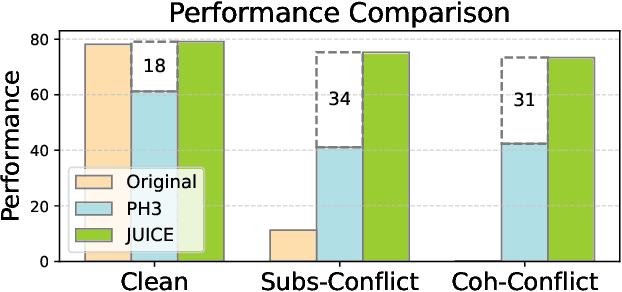
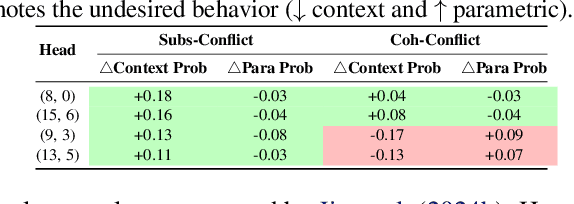

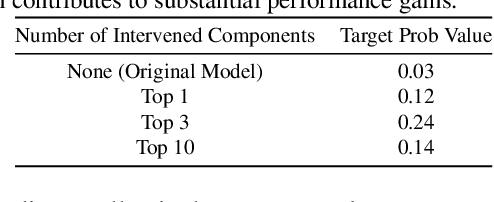
Abstract:Language Models (LMs) often encounter knowledge conflicts when parametric memory contradicts contextual knowledge. Previous works attribute this conflict to the interplay between "memory heads" and "context heads", attention heads assumed to promote either memory or context exclusively. In this study, we go beyond this fundamental assumption by uncovering a critical phenomenon we term the "superposition of contextual information and parametric memory", where highly influential attention heads could simultaneously contribute to both memory and context. Building upon this insight, we propose Just Run Twice (JUICE), a test-time attention intervention method that steers LMs toward either parametric beliefs or contextual knowledge without requiring fine-tuning. JUICE identifies a set of reliable attention heads and leverages a dual-run approach to mitigate the superposition effects. Extensive experiments across 11 datasets and 6 model architectures demonstrate that JUICE sets the new state-of-the-art performance and robust generalization, achieving significant and consistent improvement across different domains under various conflict types. Finally, we theoretically analyze knowledge conflict and the superposition of contextual information and parametric memory in attention heads, which further elucidates the effectiveness of JUICE in these settings.
On the Impact of Feature Heterophily on Link Prediction with Graph Neural Networks
Sep 26, 2024
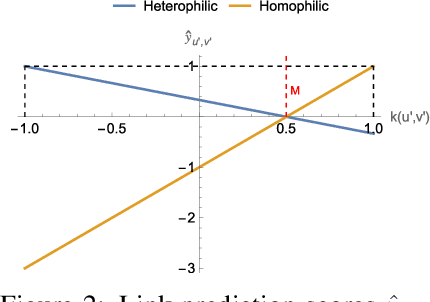
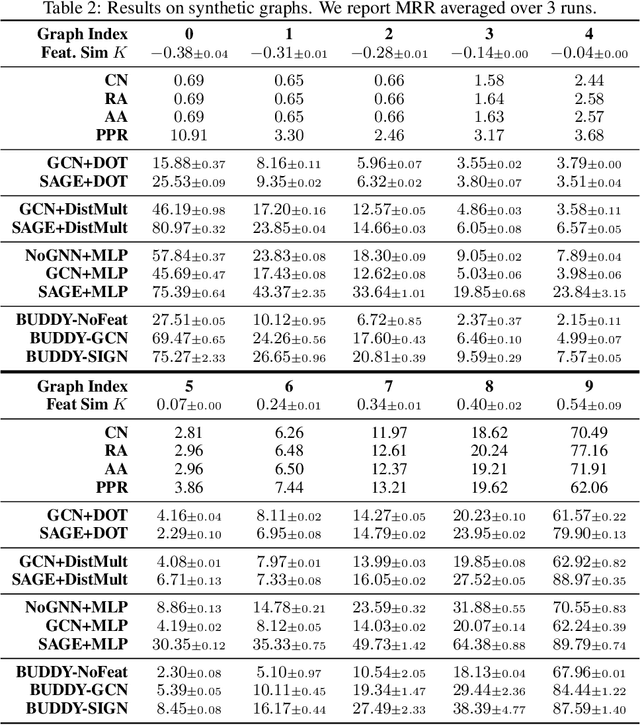
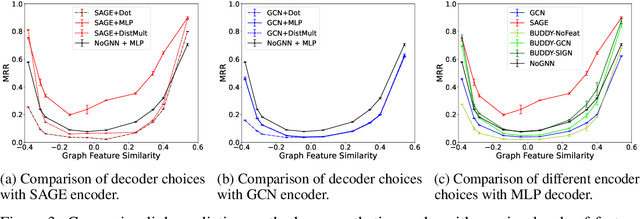
Abstract:Heterophily, or the tendency of connected nodes in networks to have different class labels or dissimilar features, has been identified as challenging for many Graph Neural Network (GNN) models. While the challenges of applying GNNs for node classification when class labels display strong heterophily are well understood, it is unclear how heterophily affects GNN performance in other important graph learning tasks where class labels are not available. In this work, we focus on the link prediction task and systematically analyze the impact of heterophily in node features on GNN performance. Theoretically, we first introduce formal definitions of homophilic and heterophilic link prediction tasks, and present a theoretical framework that highlights the different optimizations needed for the respective tasks. We then analyze how different link prediction encoders and decoders adapt to varying levels of feature homophily and introduce designs for improved performance. Our empirical analysis on a variety of synthetic and real-world datasets confirms our theoretical insights and highlights the importance of adopting learnable decoders and GNN encoders with ego- and neighbor-embedding separation in message passing for link prediction tasks beyond homophily.
Bias Amplification Enhances Minority Group Performance
Sep 13, 2023
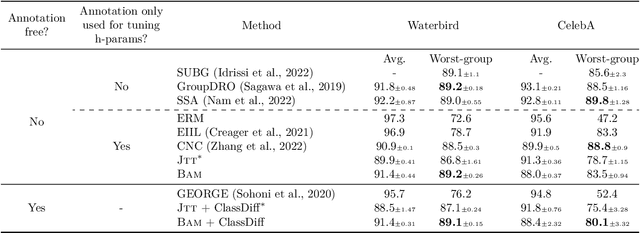
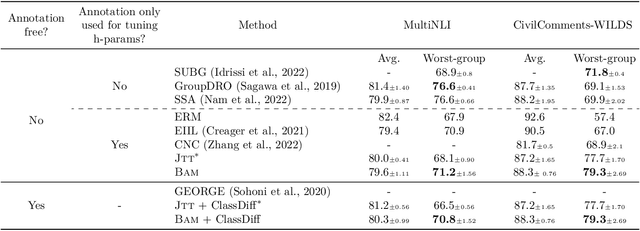
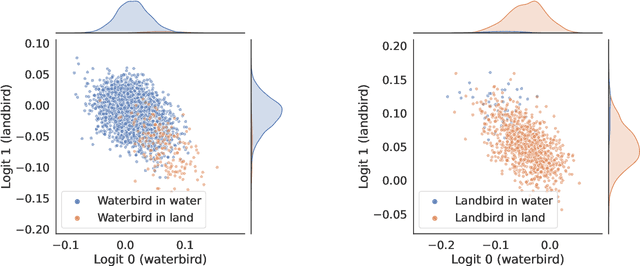
Abstract:Neural networks produced by standard training are known to suffer from poor accuracy on rare subgroups despite achieving high accuracy on average, due to the correlations between certain spurious features and labels. Previous approaches based on worst-group loss minimization (e.g. Group-DRO) are effective in improving worse-group accuracy but require expensive group annotations for all the training samples. In this paper, we focus on the more challenging and realistic setting where group annotations are only available on a small validation set or are not available at all. We propose BAM, a novel two-stage training algorithm: in the first stage, the model is trained using a bias amplification scheme via introducing a learnable auxiliary variable for each training sample; in the second stage, we upweight the samples that the bias-amplified model misclassifies, and then continue training the same model on the reweighted dataset. Empirically, BAM achieves competitive performance compared with existing methods evaluated on spurious correlation benchmarks in computer vision and natural language processing. Moreover, we find a simple stopping criterion based on minimum class accuracy difference that can remove the need for group annotations, with little or no loss in worst-group accuracy. We perform extensive analyses and ablations to verify the effectiveness and robustness of our algorithm in varying class and group imbalance ratios.
Interpretable Sparsification of Brain Graphs: Better Practices and Effective Designs for Graph Neural Networks
Jun 26, 2023



Abstract:Brain graphs, which model the structural and functional relationships between brain regions, are crucial in neuroscientific and clinical applications involving graph classification. However, dense brain graphs pose computational challenges including high runtime and memory usage and limited interpretability. In this paper, we investigate effective designs in Graph Neural Networks (GNNs) to sparsify brain graphs by eliminating noisy edges. While prior works remove noisy edges based on explainability or task-irrelevant properties, their effectiveness in enhancing performance with sparsified graphs is not guaranteed. Moreover, existing approaches often overlook collective edge removal across multiple graphs. To address these issues, we introduce an iterative framework to analyze different sparsification models. Our findings are as follows: (i) methods prioritizing interpretability may not be suitable for graph sparsification as they can degrade GNNs' performance in graph classification tasks; (ii) simultaneously learning edge selection with GNN training is more beneficial than post-training; (iii) a shared edge selection across graphs outperforms separate selection for each graph; and (iv) task-relevant gradient information aids in edge selection. Based on these insights, we propose a new model, Interpretable Graph Sparsification (IGS), which enhances graph classification performance by up to 5.1% with 55.0% fewer edges. The retained edges identified by IGS provide neuroscientific interpretations and are supported by well-established literature.
Size Generalizability of Graph Neural Networks on Biological Data: Insights and Practices from the Spectral Perspective
May 24, 2023Abstract:We investigate the question of whether the knowledge learned by graph neural networks (GNNs) from small graphs is generalizable to large graphs in the same domain. Prior works suggest that the distribution shift, particularly in the degree distribution, between graphs of different sizes can lead to performance degradation in the graph classification task. However, this may not be the case for biological datasets where the degrees are bounded and the distribution shift of degrees is small. Even with little degree distribution shift, our observations show that GNNs' performance on larger graphs from the same datasets still degrades, suggesting other causes. In fact, there has been a lack of exploration in real datasets to understand the types and properties of distribution shifts caused by various graph sizes. Furthermore, previous analyses of size generalizability mostly focus on the spatial domain. To fill these gaps, we take the spectral perspective and study the size generalizability of GNNs on biological data. We identify a distribution shift between small and large graphs in the eigenvalues of the normalized Laplacian/adjacency matrix, indicating a difference in the global node connectivity, which is found to be correlated with the node closeness centrality. We further find that despite of the variations in global connectivity, graphs of different sizes share similar local connectivity, which can be utilized to improve the size generalizability of GNNs. Based on our spectral insights and empirical observations, we propose a model-agnostic strategy, SIA, which uses size-irrelevant local structural features, i.e., the local closeness centrality of a node, to guide the learning process. Our empirical results demonstrate that our strategy improves the graph classification performance of various GNNs on small and large graphs when training with only small graphs.
 Add to Chrome
Add to Chrome Add to Firefox
Add to Firefox Add to Edge
Add to Edge